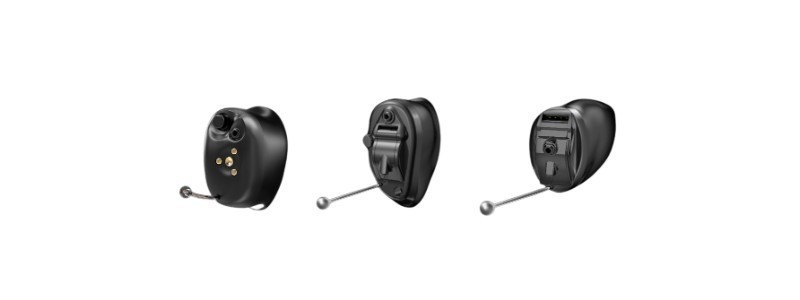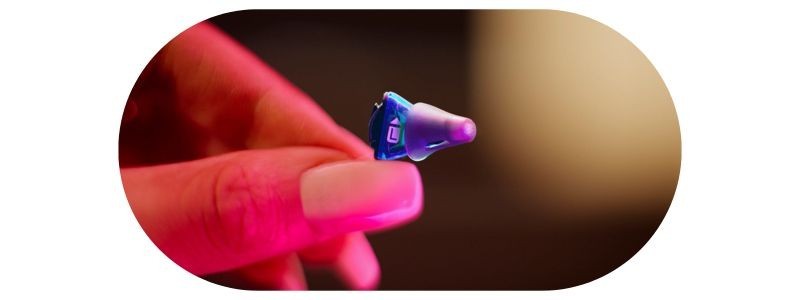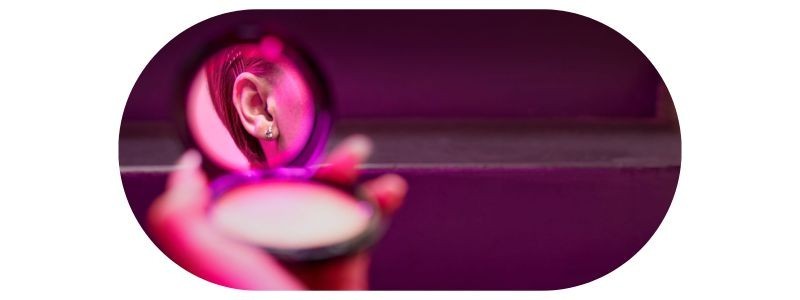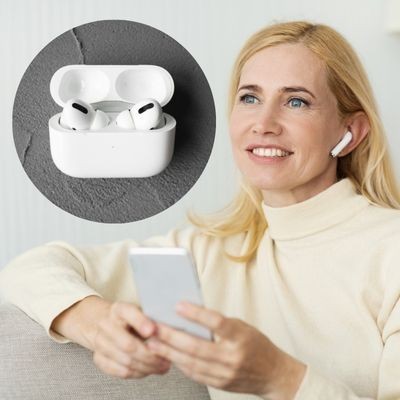
Head of Online Medical Content

Audiology Expert at Hearing Aid UK
The World's Smallest Hearing Aids
Exploring the invisible, small, and discreet hearing aids available in the UK
What are small hearing aids? | What's available? | Are small hearing aids right for everyone? | Pros and cons | Conclusion
Which is the smallest hearing aid available?
To date, the smallest hearing aids available are the Starkey Signature Series CIC R NW hearing aids. Powered by the Genesis AI platform these custom, next-generation, wireless hearing aids offer excellent sound quality whilst remaining almost completely invisible.

Discrete hearing aid styles are becoming more popular
Invisible hearing aids are small hearing solutions that cannot be seen outside your ear. This is because they sit deep inside your ear canal and are generally custom-fit. So you will benefit from both a personalised hearing experience and a comfortable fit, unique to your ear shape.
If discretion and comfort are your priority, then invisible hearing aids are worth considering. In this article, we go through the features, benefits, and impact of invisible hearing aids on hearing health.
What are invisible hearing aids?
Invisible hearing aids, also known as In-the-Canal (ITC) hearing aids or Completely-in-the-Canal (CIC) hearing aids, are designed to be as discreet as possible. This means that they are not noticeable to others when being worn, potentially giving wearers more confidence and comfort in social situations.
Many people with hearing loss are concerned about the devices themselves being too conspicuous. We know that looking after your hearing health is the most important, but confidence is also key and often being self-conscious about wearing your hearing aids affects that.
In some cases, it is the reason why so many people do not seek professional help with their hearing loss in the first place. With every year that goes by (and the smaller hearing aids become), we hope this inspires change.
What small hearing aids are available today in the UK?
Small and discreet hearing aids are broken down into different In-Ear categories. These are:
ITE hearing aids: In-the-Ear hearing aids are quite small and, as the name suggests, sit just in the ear canal. They can still be seen but are far more discreet than the Full Shell or Half Shell aids (ITC). Some manufacturers also offer colours to match hair or skin tones.
They are less visible than traditional hearing aids but may be noticeable to others if they are looking closely.
CIC hearing aids: Completely in the Canal (CIC) hearing aids sit further into the canal and are almost unnoticeable. They are almost completely hidden from view and are not visible when worn.
IIC hearing aids: Invisible in the Canal hearing aids are the most discreet type of hearing aid and are designed to be virtually invisible when worn. They are custom-made to fit deep inside the ear canal and are only visible if someone is looking directly into the ear.

Small, Invisible and Discreet Hearing Aids
Are invisible hearing aids any good?
Are invisible hearing aids suitable for everyone?
The honest answer here is no. If you are conscious about wearing hearing aids like Receiver in the Canal (RIC) or Behind the Ear (BTE) models, then - yes - invisible devices might be worth considering and opting for. However, they are not appropriate for everyone or every ear.
ITE hearing aids are generally compatible with people who have mild to moderate hearing loss. Because they are small they are not suitable or recommended for people who have severe to profound hearing loss.
They are also much trickier to handle and put into your ear, or can be a challenge when you replace your batteries. So if vision or dexterity is an issue, this type of hearing aid is probably not the best style for you.
Are small and invisible hearing aids available on the NHS?
Quite a lot of consumers choose to go private for their hearing aids to benefit from a more discreet in-the-ear device, which is historically not as available on the NHS, if not at all. The latest and most modern hearing aids that private audiologists have to offer such as advanced technology, mobile compatibility, and sophisticated Bluetooth connectivity.
Ear shape is a factor when thinking about small hearing aids
Comfort is so important when choosing hearing aids. If they are a bad fit they won't just deliver poor sound, but they will also hurt your ears and cause irritation. Invisible hearing aids are known to be comfortable, but they are not compatible with all ear shapes.
For instance, if your ear canals are short or thin, an ITE hearing aid may not sit comfortably within your ears. However, there are options to try this style of hearing aid before you commit to purchasing with your audiologist - which we would highly recommend.

Invisible and Small Hearing Aids Pros and Cons
What are the advantages and disadvantages of invisible hearing aids?
What are the advantages of invisible hearing aids?
Invisible hearing aids have several features and benefits, the main ones include:
Discretion
The main advantage of invisible hearing aids is that they are not noticeable to others when being worn. Being placed inside the ear canal, they are virtually invisible to others, addressing the stigma associated with wearing visible hearing devices.
This can be particularly important for people who are self-conscious about their hearing loss, or who do not want others to know that they are wearing a hearing aid.
Comfort with customisation and fitting
Invisible hearing aids are generally more comfortable to wear than traditional hearing aids, as they do not have any visible parts that can rub against the skin or get caught in the hair.
In regard to fit, audiologists take impressions of the wearer's ear canal, ensuring a perfect fit. This personalised fitting contributes to enhanced comfort and reduced chances of discomfort or feedback, making them ideal for extended wear.
Improved sound quality
Because they are located closer to the eardrum, invisible hearing aids can provide better sound quality than traditional hearing aids. They are also less prone to feedback (whistling) than traditional hearing aids, which can be a common issue for people with severe hearing loss.
Invisible hearing aids utilise sophisticated digital processing technology, allowing for advanced sound processing and noise reduction. These devices can adapt to various listening environments, delivering clear and natural sound to the wearer.
Speech understanding
Speech understanding is crucial for communication, and invisible hearing aids are designed to prioritise this aspect. The proximity to the eardrum ensures that sound vibrations are accurately transmitted, leading to improved speech perception even in challenging listening environments.
Compatibility with active lifestyles
Invisible hearing aids are an excellent option for individuals with active lifestyles. Whether they are engaged in sports, outdoor activities, or simply prefer a less obtrusive hearing solution, these devices offer a seamless fit and eliminate worries about their appearance.
What are the disadvantages of invisible hearing aids?
Small hearing aids come with certain limitations and considerations. While invisible hearing aids offer numerous benefits, they might not be suitable for everyone.
Individuals with severe hearing loss may require more powerful devices, which might be challenging to fit into the small form factor of invisible hearing aids. Here are some of the main disadvantages of invisible hearing aids:
Features
Invisible hearing aids historically don't have the same feature catalogue as other styles. This is because of the size of the devices and not having enough room to store such technology. This means that invisible hearing aids have shorter battery life.
Sound
Because invisible hearing aids sit inside your ear, the sound is collected and amplified. You don't have the assistance of directional microphones, which are hugely beneficial if you find a conversation in noise difficult to understand.
Connectivity
BTE hearing aids provide advanced Bluetooth connectivity for phone calls and streaming audio, and TV programmes. You might miss out on Bluetooth connectivity with most IIC or ITE hearing aids, so if this is important to you, then you need to look at other options.
Why Choose Us?
- FREE Hearing Tests
- Best Hearing Aids and Prices
- FREE Aftercare for Life
- FREE Home Visits
- 200+ Local Audiologists
- 60 Day Money Back Guarantee
Small and Invisible Hearing Aids Conclusion
Despite their many benefits, invisible hearing aids do have some drawbacks. They are typically more expensive than traditional hearing aids, and may not be suitable for people with severe hearing loss or certain types of ear shapes.
Invisible hearing aids are a good option for people who want a discreet and comfortable way to improve their hearing. If you are considering getting a hearing aid, it is important to consult with an audiologist to determine the best hearing aid solution for your individual needs.
►Click here to read our review of the best invisible hearing aids
Other articles on hearing aid advice you might like...
 Do Hearing Aids Work for Everyone?
Do Hearing Aids Work for Everyone?  Wearing Hearing Aids with Glasses
Wearing Hearing Aids with Glasses  Risks of Wearing Apple AirPod Pro 2's
Risks of Wearing Apple AirPod Pro 2's Our specialist service includes:
Do not spend hundreds of pounds without getting a second opinion from us.
Please call us on 0800 567 7621
 Not only are the prices great, but the service is fantastic! Many thanks to your team.
Not only are the prices great, but the service is fantastic! Many thanks to your team.What's included in our hearing aid prices?
Common FAQs when researching hearing aids and hearing loss
If you are looking at this page then it is likely that an audiologist has suggested that you purchase this particular hearing aid, so is this the best model for you?
In general, any audiologist will always recommend to you the model that best suits your needs. Here is a useful checklist to make sure that is the case.
- Audiologist level of knowledge: The audiologist you have seen will hopefully have a wide knowledge of all available hearing aids, however, some will only be familiar with a small number of brands and therefore may not really be in a position to know which model is the best for you. It is OK to challenge their recommendation and ask them to justify why this particular brand is the one for you.
- Do research: Read about the hearing aid that was recommended. Does it seem like it will suit your lifestyle? Does it have more or fewer features than you need?
- Be aware of sales targets: Many high street retailers have specific tie-ins to a particular manufacturer/brand. The hearing aid they have suggested may still be the correct one for you, but do your research so that you know why they might have recommended it.
If in doubt, feel free to give us a call. That's what we're here for. In the meantime, read all about our review of the best hearing aids for 2025 here
If you have significant hearing loss in both ears, you should be wearing two hearing aids. Here are the audiological reasons why:
Localisation: The brain decodes information from both ears and compares and contrasts them. By analysing the minuscule time delays as well as the difference in the loudness of each sound reaching the ears, the person is able to accurately locate a sound source. Simply put, if you have better hearing on one side than the other, you can't accurately tell what direction sounds are coming from.
Less amplification is required: A phenomenon known as “binaural summation” means that the hearing aids can be set at a lower and more natural volume setting than if you wore only one hearing aid.
Head shadow effect: High frequencies, the part of your hearing that gives clarity and meaning to speech sounds, cannot bend around your head. Only low frequencies can. Therefore if someone is talking on your unaided side you are likely to hear that they are speaking, but be unable to tell what they have said.
Noise reduction: The brain has its own built-in noise reduction which is only really effective when it is receiving information from both ears. If only one ear is aided, even with the best hearing aid in the world, it will be difficult for you to hear in background noise as your brain is trying to retain all of the sounds (including background noise) rather than filtering it out.
Sound quality: We are designed to hear in stereo. Only hearing from one side sounds a lot less natural to us.
Fancy some further reading on this topic? You can read about why two hearing aids are better than one in our article, hearing aids for both ears, here
For most people, the main benefit of a rechargeable hearing aid is simple convenience. We are used to plugging in our phones and other devices overnight for them to charge up. Here are some other pros and cons:
For anybody with poor dexterity or issues with their fingers, having a rechargeable aid makes a huge difference as normal hearing aid batteries are quite small and some people find them fiddly to change.
One downside is that if you forget to charge your hearing aid, then it is a problem that can't be instantly fixed. For most a 30-minute charge will get you at least two or three hours of hearing, but if you are the type of person who is likely to forget to plug them in regularly then you're probably better off with standard batteries.
Rechargeable aids are also a little bit bigger and are only available in Behind the Ear models.
Finally, just like with a mobile phone, the amount of charge you get on day one is not going to be the same as you get a few years down the line. Be sure to ask what the policy is with the manufacturer warranty when it comes to replacing the battery.
Looking for more information on rechargeable hearing aids? Read our dedicated page on the topic here
For most people, the answer is yes. But it's never that simple.
The majority of hearing problems affect the high frequencies a lot more than the low ones. Therefore open fitting hearing aids sound a lot more natural and ones that block your ears up can make your own voice sound like you are talking with your head in a bucket. Therefore in-ear aids tend to be less natural.
However the true answer is we can't tell until we have had a look in your ears to assess the size of your ear canal, and until we have tested your hearing to see which frequencies are being affected.
People with wider ear canals tend to have more flexibility, also there are open fitting modular CIC hearing aids now that do not block your ears.
There is also the age old rule to consider, that a hearing aid will not help you if it's sat in the drawer gathering dust. If the only hearing aid you would be happy wearing is one that people can't see, then that's what you should get.
Most people can adapt to any type of hearing aid, as long as they know what to expect. Have an honest conversation with your audiologist as to what your needs are.
Generally speaking, six or more. Unless it's none at all.
The number of channels a hearing aid has is often a simplistic way an audiologist will use to explain why one hearing aid is better than another, but channels are complex and it is really not that straightforward. Here are some reasons why:
Hearing aids amplify sounds of different frequencies by different amounts. Most people have lost more high frequencies than low and therefore need more amplification in the high frequencies. The range of sounds you hear are split into frequency bands or channels and the hearing aids are set to provide the right amount of hearing at each frequency level.
Less than six channels and this cannot be done with much accuracy, so six is the magic number. However, a six channel aid is typically very basic with few other features and is suitable only for hearing a single speaker in a quiet room. The number of channels is not what you should be looking at, it's more the rest of the technology that comes with them.
As a final note, different manufacturers have different approaches. One method is not necessarily better than any other. For example, some manufacturers have as many as 64 channels in their top aids. Most tend to have between 17 and 20. One manufacturer has no channels at all.
Hearing aids are easily lost, misplaced or damaged and typically are one of the most expensive personal possessions an individual can own. We offer hearing aid warranty coverage for £80 per year per aid. Find out more about this service we provide here
All our audiologists use the very latest technology and provide the full range of tests to accurately measure your hearing for free. Find out about what hearing healthcare services we offer all our customers here
Hearing Aid UK offers all their customers free home visiting services, even in a care home environment, for no extra cost. Including hearing tests, fittings, maintenance, check-ups and much more in the comfort of your own home and at your convenience. Find out more information about our home visits here
Here, at Hearing Aid UK, we are dedicated to offering low hearing aid prices. We achieve this by having no head office and low marketing costs. Our hearing aid prices are amongst the lowest you will find anywhere in the world. Explore our prices, brands, and models here
Other pages you might find useful
Ask the Experts
6 Morton Lane
Walkwood
Redditch
Worcestershire
B97 5QA
Latest Launch
When we refer to a product as 'Latest Launch', we mean it is the latest to be released on the market.
New
When we refer to a product as 'New', we mean that the product is the newest hearing aid model on the market.
When we refer to a product as 'Superseded', we mean that there is a newer range available which replaces and improves on this product.
Older Model
When we refer to a product as an 'Older Model', we mean that it is has been superseded by at least two more recent hearing aid ranges.
